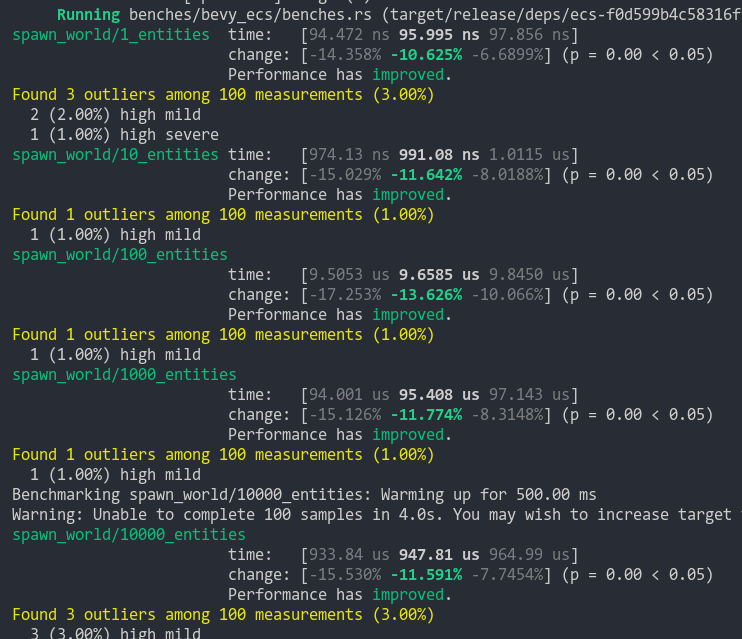mirror of
https://github.com/bevyengine/bevy
synced 2024-09-20 14:32:06 +00:00
# Objective Now that we can consolidate Bundles and Components under a single insert (thanks to #2975 and #6039), almost 100% of world spawns now look like `world.spawn().insert((Some, Tuple, Here))`. Spawning an entity without any components is an extremely uncommon pattern, so it makes sense to give spawn the "first class" ergonomic api. This consolidated api should be made consistent across all spawn apis (such as World and Commands). ## Solution All `spawn` apis (`World::spawn`, `Commands:;spawn`, `ChildBuilder::spawn`, and `WorldChildBuilder::spawn`) now accept a bundle as input: ```rust // before: commands .spawn() .insert((A, B, C)); world .spawn() .insert((A, B, C); // after commands.spawn((A, B, C)); world.spawn((A, B, C)); ``` All existing instances of `spawn_bundle` have been deprecated in favor of the new `spawn` api. A new `spawn_empty` has been added, replacing the old `spawn` api. By allowing `world.spawn(some_bundle)` to replace `world.spawn().insert(some_bundle)`, this opened the door to removing the initial entity allocation in the "empty" archetype / table done in `spawn()` (and subsequent move to the actual archetype in `.insert(some_bundle)`). This improves spawn performance by over 10%:  To take this measurement, I added a new `world_spawn` benchmark. Unfortunately, optimizing `Commands::spawn` is slightly less trivial, as Commands expose the Entity id of spawned entities prior to actually spawning. Doing the optimization would (naively) require assurances that the `spawn(some_bundle)` command is applied before all other commands involving the entity (which would not necessarily be true, if memory serves). Optimizing `Commands::spawn` this way does feel possible, but it will require careful thought (and maybe some additional checks), which deserves its own PR. For now, it has the same performance characteristics of the current `Commands::spawn_bundle` on main. **Note that 99% of this PR is simple renames and refactors. The only code that needs careful scrutiny is the new `World::spawn()` impl, which is relatively straightforward, but it has some new unsafe code (which re-uses battle tested BundlerSpawner code path).** --- ## Changelog - All `spawn` apis (`World::spawn`, `Commands:;spawn`, `ChildBuilder::spawn`, and `WorldChildBuilder::spawn`) now accept a bundle as input - All instances of `spawn_bundle` have been deprecated in favor of the new `spawn` api - World and Commands now have `spawn_empty()`, which is equivalent to the old `spawn()` behavior. ## Migration Guide ```rust // Old (0.8): commands .spawn() .insert_bundle((A, B, C)); // New (0.9) commands.spawn((A, B, C)); // Old (0.8): commands.spawn_bundle((A, B, C)); // New (0.9) commands.spawn((A, B, C)); // Old (0.8): let entity = commands.spawn().id(); // New (0.9) let entity = commands.spawn_empty().id(); // Old (0.8) let entity = world.spawn().id(); // New (0.9) let entity = world.spawn_empty(); ```
104 lines
3 KiB
Rust
104 lines
3 KiB
Rust
use bevy::{
|
|
asset::LoadState,
|
|
prelude::*,
|
|
reflect::TypeUuid,
|
|
render::render_resource::{AsBindGroup, ShaderRef},
|
|
};
|
|
|
|
/// This example illustrates how to create a texture for use with a `texture_2d_array<f32>` shader
|
|
/// uniform variable.
|
|
fn main() {
|
|
App::new()
|
|
.add_plugins(DefaultPlugins)
|
|
.add_plugin(MaterialPlugin::<ArrayTextureMaterial>::default())
|
|
.add_startup_system(setup)
|
|
.add_system(create_array_texture)
|
|
.run();
|
|
}
|
|
|
|
#[derive(Resource)]
|
|
struct LoadingTexture {
|
|
is_loaded: bool,
|
|
handle: Handle<Image>,
|
|
}
|
|
|
|
fn setup(mut commands: Commands, asset_server: Res<AssetServer>) {
|
|
// Start loading the texture.
|
|
commands.insert_resource(LoadingTexture {
|
|
is_loaded: false,
|
|
handle: asset_server.load("textures/array_texture.png"),
|
|
});
|
|
|
|
// light
|
|
commands.spawn(PointLightBundle {
|
|
point_light: PointLight {
|
|
intensity: 3000.0,
|
|
..Default::default()
|
|
},
|
|
transform: Transform::from_xyz(-3.0, 2.0, -1.0),
|
|
..Default::default()
|
|
});
|
|
commands.spawn(PointLightBundle {
|
|
point_light: PointLight {
|
|
intensity: 3000.0,
|
|
..Default::default()
|
|
},
|
|
transform: Transform::from_xyz(3.0, 2.0, 1.0),
|
|
..Default::default()
|
|
});
|
|
|
|
// camera
|
|
commands.spawn(Camera3dBundle {
|
|
transform: Transform::from_xyz(5.0, 5.0, 5.0).looking_at(Vec3::new(1.5, 0.0, 0.0), Vec3::Y),
|
|
..Default::default()
|
|
});
|
|
}
|
|
|
|
fn create_array_texture(
|
|
mut commands: Commands,
|
|
asset_server: Res<AssetServer>,
|
|
mut loading_texture: ResMut<LoadingTexture>,
|
|
mut images: ResMut<Assets<Image>>,
|
|
mut meshes: ResMut<Assets<Mesh>>,
|
|
mut materials: ResMut<Assets<ArrayTextureMaterial>>,
|
|
) {
|
|
if loading_texture.is_loaded
|
|
|| asset_server.get_load_state(loading_texture.handle.clone()) != LoadState::Loaded
|
|
{
|
|
return;
|
|
}
|
|
loading_texture.is_loaded = true;
|
|
let image = images.get_mut(&loading_texture.handle).unwrap();
|
|
|
|
// Create a new array texture asset from the loaded texture.
|
|
let array_layers = 4;
|
|
image.reinterpret_stacked_2d_as_array(array_layers);
|
|
|
|
// Spawn some cubes using the array texture
|
|
let mesh_handle = meshes.add(Mesh::from(shape::Cube { size: 1.0 }));
|
|
let material_handle = materials.add(ArrayTextureMaterial {
|
|
array_texture: loading_texture.handle.clone(),
|
|
});
|
|
for x in -5..=5 {
|
|
commands.spawn(MaterialMeshBundle {
|
|
mesh: mesh_handle.clone(),
|
|
material: material_handle.clone(),
|
|
transform: Transform::from_xyz(x as f32 + 0.5, 0.0, 0.0),
|
|
..Default::default()
|
|
});
|
|
}
|
|
}
|
|
|
|
#[derive(AsBindGroup, Debug, Clone, TypeUuid)]
|
|
#[uuid = "9c5a0ddf-1eaf-41b4-9832-ed736fd26af3"]
|
|
struct ArrayTextureMaterial {
|
|
#[texture(0, dimension = "2d_array")]
|
|
#[sampler(1)]
|
|
array_texture: Handle<Image>,
|
|
}
|
|
|
|
impl Material for ArrayTextureMaterial {
|
|
fn fragment_shader() -> ShaderRef {
|
|
"shaders/array_texture.wgsl".into()
|
|
}
|
|
}
|